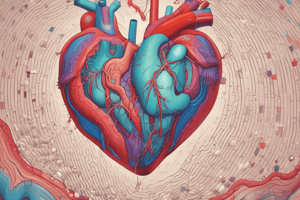Podcast
Questions and Answers
In a pain assessment tool, what does the 'T' column represent?
In a pain assessment tool, what does the 'T' column represent?
- Timing - when did the pain start
- Type - what type of pain are you experiencing
- Treatment - what medications work for you (correct)
- Treatment - what to do to relieve the pain
What is the purpose of a Visual Analog pain assessment tool?
What is the purpose of a Visual Analog pain assessment tool?
- To assess the type of pain
- To determine the cause of pain
- To monitor the progress of pain treatment
- To measure the intensity of pain (correct)
What is an example of a behavioral response to pain?
What is an example of a behavioral response to pain?
- Guarding or protecting the affected area (correct)
- Experiencing anxiety or fear
- Demonstrating aggressive behavior
- All of the above
What is the role of the nurse in pain management?
What is the role of the nurse in pain management?
What is the main purpose of a pain assessment tool?
What is the main purpose of a pain assessment tool?
What is an example of an affective response to pain?
What is an example of an affective response to pain?
What is the purpose of the 'D' column in a pain assessment tool?
What is the purpose of the 'D' column in a pain assessment tool?
What is the significance of acute pain?
What is the significance of acute pain?
What is the primary goal of management in preventing thrombus?
What is the primary goal of management in preventing thrombus?
What is the first step in managing a patient who has undergone thrombolytic therapy?
What is the first step in managing a patient who has undergone thrombolytic therapy?
What is the classification of hemorrhage based on?
What is the classification of hemorrhage based on?
What is the primary focus of nursing interventions in managing hemorrhage?
What is the primary focus of nursing interventions in managing hemorrhage?
What is the purpose of WHO grading in managing hemorrhage?
What is the purpose of WHO grading in managing hemorrhage?
What is the primary indication for thrombolytic therapy?
What is the primary indication for thrombolytic therapy?
What is the normal range for activated partial thromboplastin time (aPTT) in seconds?
What is the normal range for activated partial thromboplastin time (aPTT) in seconds?
What is the term for a decrease in platelets in the blood?
What is the term for a decrease in platelets in the blood?
What is the name of the anticoagulation agent that is also known as Arixtra?
What is the name of the anticoagulation agent that is also known as Arixtra?
What is the normal range for hematocrit (HCT) in males?
What is the normal range for hematocrit (HCT) in males?
What is the term for a blood clot that has broken loose and traveled to the lungs?
What is the term for a blood clot that has broken loose and traveled to the lungs?
What is the name of the anticoagulation agent that is also known as Coumadin?
What is the name of the anticoagulation agent that is also known as Coumadin?
What is the normal range for hemoglobin (HGB) in females?
What is the normal range for hemoglobin (HGB) in females?
What is the term for a condition in which the blood clotting mechanism is activated, leading to a decrease in platelets?
What is the term for a condition in which the blood clotting mechanism is activated, leading to a decrease in platelets?
What is the primary mechanism of action of NSAIDs in relieving pain and reducing inflammation?
What is the primary mechanism of action of NSAIDs in relieving pain and reducing inflammation?
What is the primary advantage of multimodal analgesia?
What is the primary advantage of multimodal analgesia?
What is a potential adverse effect of chronic NSAID use in older adults?
What is a potential adverse effect of chronic NSAID use in older adults?
What is the role of adjuvants/co-analgesics in the World Health Organization Analgesic Ladder?
What is the role of adjuvants/co-analgesics in the World Health Organization Analgesic Ladder?
Why may children not complain of pain?
Why may children not complain of pain?
What is the primary risk associated with the use of meperidine (Demerol)?
What is the primary risk associated with the use of meperidine (Demerol)?
What is the purpose of pain assessment tools?
What is the purpose of pain assessment tools?
What is the primary consideration in the pharmacological management of pain in older adults?
What is the primary consideration in the pharmacological management of pain in older adults?
Which type of pain is predictable and elicited by specific behaviors?
Which type of pain is predictable and elicited by specific behaviors?
What is the primary goal of collaboration with patients and families in making pain management decisions?
What is the primary goal of collaboration with patients and families in making pain management decisions?
Which of the following non-pharmacological therapies involves the use of instrumentation to mirror psychophysiologic processes?
Which of the following non-pharmacological therapies involves the use of instrumentation to mirror psychophysiologic processes?
What is the primary goal of therapeutic touch in pain management?
What is the primary goal of therapeutic touch in pain management?
Which of the following is a characteristic of severe pain in children?
Which of the following is a characteristic of severe pain in children?
What is the primary goal of patient-controlled analgesia (PCA)?
What is the primary goal of patient-controlled analgesia (PCA)?
What is the primary role of family/caregivers in pain management?
What is the primary role of family/caregivers in pain management?
What is the primary goal of chiropractic care in pain management?
What is the primary goal of chiropractic care in pain management?
What is the term for a decrease in platelets in the blood?
What is the term for a decrease in platelets in the blood?
What is the normal range for activated partial thromboplastin time (aPTT) in seconds?
What is the normal range for activated partial thromboplastin time (aPTT) in seconds?
What is the name of the anticoagulation agent that is also known as Arixtra?
What is the name of the anticoagulation agent that is also known as Arixtra?
What is the term for a blood clot that has broken loose and traveled to the lungs?
What is the term for a blood clot that has broken loose and traveled to the lungs?
What is the primary mechanism of action of anticoagulation therapy?
What is the primary mechanism of action of anticoagulation therapy?
What is the normal range for hematocrit (HCT) in females?
What is the normal range for hematocrit (HCT) in females?
What is the name of the anticoagulation agent that is also known as Coumadin?
What is the name of the anticoagulation agent that is also known as Coumadin?
What is the primary goal of anticoagulation therapy?
What is the primary goal of anticoagulation therapy?
Which fluid volume imbalance is characterized by a decreased hematocrit and decreased serum osmolality?
Which fluid volume imbalance is characterized by a decreased hematocrit and decreased serum osmolality?
What is a common cause of fluid volume deficit?
What is a common cause of fluid volume deficit?
Which of the following is a symptom of fluid volume excess?
Which of the following is a symptom of fluid volume excess?
What is the primary cause of diabetes insipidus?
What is the primary cause of diabetes insipidus?
Which of the following is a complication of fluid volume excess?
Which of the following is a complication of fluid volume excess?
What is the primary treatment for fluid volume deficit?
What is the primary treatment for fluid volume deficit?
Which of the following is a sign of fluid volume deficit?
Which of the following is a sign of fluid volume deficit?
What is the primary cause of hyperaldosteronism?
What is the primary cause of hyperaldosteronism?
Which of the following is a characteristic of fluid volume excess?
Which of the following is a characteristic of fluid volume excess?
What is the primary goal of fluid management in patients with fluid volume deficit?
What is the primary goal of fluid management in patients with fluid volume deficit?
What is the primary purpose of the 'R' column in a pain assessment tool?
What is the primary purpose of the 'R' column in a pain assessment tool?
What type of response to pain is characterized by changes in a patient's behavior?
What type of response to pain is characterized by changes in a patient's behavior?
What is the primary cause of hypovolemic shock?
What is the primary cause of hypovolemic shock?
What is the primary goal of a nurse's teaching plan for a patient with pain?
What is the primary goal of a nurse's teaching plan for a patient with pain?
What is the purpose of using a Visual Analog pain assessment tool?
What is the purpose of using a Visual Analog pain assessment tool?
What is the characteristic of blood pressure in the compensatory stage of shock?
What is the characteristic of blood pressure in the compensatory stage of shock?
What is an example of an affective response to pain?
What is an example of an affective response to pain?
What is the primary characteristic of the irreversible stage of shock?
What is the primary characteristic of the irreversible stage of shock?
What is the significance of acute pain?
What is the significance of acute pain?
What is the primary focus of nursing interventions in managing shock?
What is the primary focus of nursing interventions in managing shock?
What type of pain is predictable and elicited by specific behaviors?
What type of pain is predictable and elicited by specific behaviors?
What is the classification of shock based on the underlying cause?
What is the classification of shock based on the underlying cause?
What is the primary role of the nurse in pain management?
What is the primary role of the nurse in pain management?
What is the characteristic of respiratory rate in the progressive stage of shock?
What is the characteristic of respiratory rate in the progressive stage of shock?
What is the primary indication for thrombolytic therapy in the management of shock?
What is the primary indication for thrombolytic therapy in the management of shock?
What is the characteristic of urinary output in the compensatory stage of shock?
What is the characteristic of urinary output in the compensatory stage of shock?
What is the primary difference between nociceptive and neuropathic pain?
What is the primary difference between nociceptive and neuropathic pain?
Which of the following is an example of a potential barrier to effective pain assessment and management?
Which of the following is an example of a potential barrier to effective pain assessment and management?
What is the primary benefit of effective pain management?
What is the primary benefit of effective pain management?
According to the Gate-Control Theory of Pain, what is the primary mechanism of pain relief?
According to the Gate-Control Theory of Pain, what is the primary mechanism of pain relief?
What is the primary classification of pain that is caused by abnormal processing of sensory input?
What is the primary classification of pain that is caused by abnormal processing of sensory input?
What is the primary role of nursing responsibilities and accountabilities in pain management?
What is the primary role of nursing responsibilities and accountabilities in pain management?
What is the primary factor that influences the severity of pain?
What is the primary factor that influences the severity of pain?
What is the primary purpose of the PQRST pain assessment tool?
What is the primary purpose of the PQRST pain assessment tool?
Flashcards are hidden until you start studying
Study Notes
Heparin Induced Thrombocytopenia (HIT)
- Heparin induced thrombocytopenia (HIT) occurs when the body's immune system reacts to the presence of heparin, leading to a low platelet count.
Anticoagulation Agents
- Low-Molecular-Weight Heparin (LMWH) is used to prevent and treat blood clots.
- Fondaparinux (Arixtra) is a type of anticoagulant that inhibits the formation of blood clots.
- Oral anticoagulants, such as warfarin (Coumadin), are used to prevent and treat blood clots.
- The antidote for warfarin (Coumadin) is vitamin K.
Blood Work
- International Normalized Ratio (INR) is a test used to measure the effectiveness of warfarin (Coumadin) therapy.
- Activated partial prothrombin time (aPTT) is a test used to measure the effectiveness of heparin therapy.
- Prothrombin time (PT) is a test used to measure the blood's clotting ability.
- Platelet count is a test used to measure the number of platelets in the blood.
- Hemoglobin (HGB) and hematocrit (HCT) are tests used to measure the amount of red blood cells in the blood.
Anticoagulation Therapy Monitoring
- INR and aPTT are used to monitor the effectiveness of anticoagulant therapy.
- Platelet count is used to monitor for thrombocytopenia (low platelet count).
- Bleeding is a complication of anticoagulation therapy.
- Numerous drug interactions can occur with anticoagulation therapy.
Thrombocytopenia
- Thrombocytopenia is a decrease in platelets, which can lead to bleeding.
- Platelet count is used to diagnose thrombocytopenia.
Anticoagulation Therapy Management
- Anticoagulation therapy is used to prevent and treat blood clots.
- Numerous drug interactions can occur with anticoagulation therapy.
- Bleeding is a complication of anticoagulation therapy.
Pulmonary Embolism (PE)
- PE occurs when a blood clot travels to the lungs and blocks an artery.
- PE risk factors include immobility, cancer, and surgery.
- Signs and symptoms of PE include chest pain, shortness of breath, and coughing.
- Diagnostic tests for PE include D-dimer, CT scan, and ventilation/perfusion scan.
- Interventions for PE include anticoagulation therapy, thrombolytic therapy, and surgery.
Hemorrhage
- Hemorrhage is a loss of a large amount of blood externally or internally in a short period of time.
- Classification of hemorrhage includes type of vessel and visibility.
- WHO grading system is used to measure bleeding.
- Signs and symptoms of hemorrhage include tachycardia, hypotension, and tachypnea.
Pain Assessment
- Pain assessment tools include visual analog, FACES, and numerical rating scales.
- Affective responses to pain include anxiety, fear, and depression.
- Behavioral responses to pain include changes in sleep, appetite, and activity.
- Physiological responses to pain include increased heart rate, blood pressure, and respiratory rate.
Pharmacological Pain Management
- Non-opioid analgesics, such as acetaminophen and NSAIDs, are used to treat mild to moderate pain.
- Opioids, such as morphine and codeine, are used to treat moderate to severe pain.
- Adjuvants, such as antidepressants and anti-inflammatories, are used to treat pain.
- Routes of administration for pain medications include oral, intravenous, and epidural.
Opioids
- Tolerance, physical dependence, and addiction are risks associated with opioid use.
- Patient-controlled analgesia (PCA) is a method of pain management that allows patients to self-administer pain medication.
- Epidural analgesia is a method of pain management that involves injecting pain medication into the epidural space.
Non-Pharmacological Pain Therapy
- Non-pharmacological approaches to pain management include relaxation, distraction, and guided imagery.
- Complementary or alternative therapies, such as biofeedback, therapeutic touch, and reiki, can be used to manage pain.
- Collaboration with patients and families is necessary in making pain management decisions.
Heparin Induced Thrombocytopenia (HIT)
- Low platelet count due to heparin use
- Risk of thrombosis and bleeding
Anticoagulation Agents
- Low-Molecular-Weight Heparin (LMWH)
- Fondaparinux (Arixtra)
- Oral Anticoagulants (e.g. warfarin)
Antidote for Warfarin (Coumadin)
- Vitamin K
Systemic Thrombolytic Therapy
- Used to dissolve blood clots
Surgical Management
- Indicated for bleeding, severe trauma, severe liver or renal disease, CVA, and other conditions
- Contraindications: bleeding, severe trauma, and other conditions
Blood Work
- INR (International Normalized Ratio): 0.9-1.1
- aPTT (activated partial prothrombin time): 28-38 seconds
- PT (prothrombin time): 10-14 seconds
- Platelet count: 150-400 x 10^9/L
- Hemoglobin (HGB): 135-170 g/L (male), 115-160 g/L (female)
- Hematocrit (HCT): 0.4-0.51 (male), 0.34-0.48 (female)
Anticoagulation Therapy Monitoring
- Monitor INR, aPTT, PT, and platelet count
- Monitor for bleeding and thrombosis
Bleeding
- Monitor for signs of bleeding (e.g. tachycardia, hypotension, petechiae)
- Manage bleeding with fluid replacement, blood transfusion, and surgical intervention
Thrombocytopenia
- Decreased platelet count
- Monitor for signs of bleeding
Anticoagulation Therapy Management
- Manage anticoagulation therapy to prevent bleeding and thrombosis
- Monitor for signs of bleeding and thrombosis
Numerical Drug Interactions
- Monitor for interactions with other medications
Client Comfort and Healing
- Promote comfort and healing through pain management and wound care
Adjuncts to Therapy
- Use of compression stockings, ambulation, and other therapies to promote healing
Pulmonary Embolism (PE)
- Blockage of pulmonary artery by blood clot
- Risk factors: immobility, surgery, cancer, and others
- Signs and symptoms: chest pain, dyspnea, tachycardia, and others
Shock
- Definition: inadequate perfusion of tissues
- Stages: compensatory, progressive, and irreversible
- Clinical signs: hypotension, tachycardia, tachypnea, and others
- Classifications: hypovolemic, cardiogenic, distributive, and others
- Management: fluid resuscitation, vasopressors, and others
Types of Pain
- Acute pain: short-term, severe pain
- Chronic pain: long-term, persistent pain
- Idiopathic pain: pain without clear cause
Physiology of Pain
- Nociceptors: specialized nerve cells that detect pain
- Gate-control theory: pain transmission through spinal cord
Factors Influencing Pain
- Age, anxiety, and others
- Nursing responsibilities: pain assessment and management
Pain Assessment Tools
- Visual Analog Scale (VAS)
- FACES scale
- PQRST assessment
Responses to Pain
- Affective: emotional response to pain
- Behavioral: physical response to pain
Physiological Responses to Pain
- Acute pain is a warning to the body
- Chronic pain can lead to physiological changes
Studying That Suits You
Use AI to generate personalized quizzes and flashcards to suit your learning preferences.




